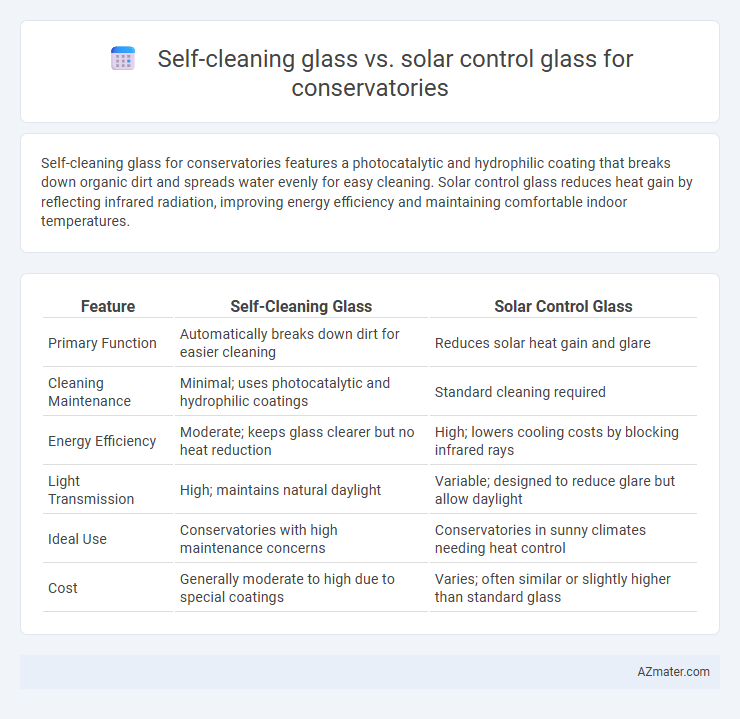Self-cleaning glass for conservatories features a photocatalytic and hydrophilic coating that breaks down organic dirt and spreads water evenly for easy cleaning. Solar control glass reduces heat gain by reflecting infrared radiation, improving energy efficiency and maintaining comfortable indoor temperatures.
Table of Comparison
| Feature | Self-Cleaning Glass | Solar Control Glass |
|---|---|---|
| Primary Function | Automatically breaks down dirt for easier cleaning | Reduces solar heat gain and glare |
| Cleaning Maintenance | Minimal; uses photocatalytic and hydrophilic coatings | Standard cleaning required |
| Energy Efficiency | Moderate; keeps glass clearer but no heat reduction | High; lowers cooling costs by blocking infrared rays |
| Light Transmission | High; maintains natural daylight | Variable; designed to reduce glare but allow daylight |
| Ideal Use | Conservatories with high maintenance concerns | Conservatories in sunny climates needing heat control |
| Cost | Generally moderate to high due to special coatings | Varies; often similar or slightly higher than standard glass |
Introduction to Self-Cleaning and Solar Control Glass
Self-cleaning glass uses a photocatalytic and hydrophilic coating to break down organic dirt and allow rainwater to wash it away, reducing maintenance for conservatories. Solar control glass incorporates a special low-emissivity or reflective coating to minimize heat gain from sunlight, enhancing indoor comfort and energy efficiency. Both technologies improve the usability of conservatories by addressing specific environmental challenges related to dirt accumulation and solar heat.
How Self-Cleaning Glass Works in Conservatories
Self-cleaning glass in conservatories features a titanium dioxide coating that breaks down organic dirt through photochemical reactions when exposed to sunlight. This technology allows rainwater to spread evenly, washing away loosened dirt and reducing maintenance efforts. Compared to solar control glass, which primarily reflects heat to regulate temperature, self-cleaning glass enhances transparency and cleanliness without compromising light transmission.
Principles of Solar Control Glass Technology
Solar control glass for conservatories utilizes advanced coating technologies such as low-emissivity (low-E) and reflective layers to manage solar heat gain by reflecting infrared radiation while allowing visible light transmission. These coatings improve indoor comfort by reducing glare and minimizing temperature fluctuations, thereby enhancing energy efficiency. Unlike self-cleaning glass, which features a photocatalytic and hydrophilic surface to break down organic dirt and promote rainwater sheet-off, solar control glass primarily focuses on thermal regulation through its spectrally selective properties.
Comparing Maintenance Requirements: Self-Cleaning vs. Solar Control Glass
Self-cleaning glass significantly reduces maintenance by using a photocatalytic coating that breaks down organic dirt, allowing rainwater to wash it away, resulting in less frequent cleaning compared to solar control glass. Solar control glass primarily reduces heat and glare but requires regular cleaning since it lacks self-cleaning properties. Choosing self-cleaning glass for conservatories minimizes manual cleaning efforts and upkeep costs, while solar control glass demands standard maintenance despite enhancing energy efficiency.
Energy Efficiency: Which Glass Offers Better Performance?
Solar control glass offers superior energy efficiency for conservatories by significantly reducing heat gain and loss, maintaining a more stable indoor temperature and lowering cooling and heating costs. Self-cleaning glass primarily improves maintenance convenience but has minimal impact on thermal insulation or energy performance. For optimal energy savings and enhanced comfort, solar control glass is the preferred choice over self-cleaning glass in conservatory applications.
Impact on Comfort: Temperature and Light Management
Self-cleaning glass enhances conservatory comfort by maintaining clearer surfaces, ensuring maximum natural light penetration while reducing maintenance efforts. Solar control glass optimizes temperature regulation by reflecting excessive solar heat, significantly lowering indoor temperatures and minimizing glare for improved occupant comfort. Combining these technologies can create a balanced environment, maximizing light management and thermal comfort throughout the year.
Aesthetic Differences and Visual Clarity
Self-cleaning glass offers superior visual clarity by minimizing dirt and water stains through its hydrophilic coating, maintaining a consistently clear appearance for conservatories. Solar control glass reduces glare and heat transmission with its tinted or reflective surface, which can slightly affect the overall brightness and natural color perception inside the space. Aesthetically, self-cleaning glass retains a more transparent, natural look, whereas solar control glass introduces a subtle shading effect that enhances comfort but may alter the external and internal visual appeal.
Cost Considerations: Initial Investment and Long-Term Savings
Self-cleaning glass for conservatories typically carries a higher initial investment due to its advanced photocatalytic and hydrophilic coatings that reduce maintenance costs over time. Solar control glass, while often cheaper upfront, offers significant long-term savings by minimizing cooling expenses through superior heat rejection properties. Evaluating cost considerations involves balancing the upfront price of self-cleaning technology against the energy efficiency benefits and reduced cleaning frequency provided by solar control glass.
Environmental Benefits of Each Glass Type
Self-cleaning glass for conservatories uses photocatalytic and hydrophilic coatings to break down organic dirt and rainwater to wash it away, reducing the need for chemical cleaners and water consumption, thereby lowering environmental impact. Solar control glass minimizes heat gain by reflecting solar radiation, enhancing energy efficiency by reducing the need for air conditioning and lowering greenhouse gas emissions. Both glass types contribute to sustainable building practices by improving energy efficiency and reducing maintenance-related environmental footprints.
Choosing the Best Glass for Your Conservatory Needs
Self-cleaning glass for conservatories offers low-maintenance benefits by using a special coating that breaks down organic dirt when exposed to sunlight and allows rainwater to wash it away, keeping the glass clearer for longer periods. Solar control glass is designed to reduce heat gain and UV rays, helping maintain a comfortable indoor temperature while protecting furnishings from fading, making it ideal for energy efficiency and climate control. Choosing the best glass depends on whether low maintenance or solar performance is a priority, with some options combining coatings for both benefits in a single pane.

Infographic: Self-cleaning glass vs Solar control glass for Conservatory
 azmater.com
azmater.com